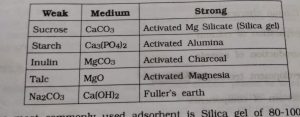Column Chromatography: Introduction,Principle and Important Questions for GPAT, GATE and UGC NET JRF
Introduction :-
- Column Chromatography is a method of analysis in which the stationary phase is allowed to migrate across the surface of the column.
- The column is simply a glass tube with a stopcock at the bottom.
- The column is filled with stationary phase and impure product is placed on the top of the stationary phase.
- As the solvent is through out the column, the compound in the impure product slowly pass down through the stationary phase.
- In column Chromatography mainly stationary phase is silica gel or alumina.
There are mainly two types of column Chromatography
1. Adsorption chromatography
2. Partition Chromatography
principle :-
Adsorption column Chromatography is work on principal of adsorption at the solid- liquid interface.
When a mixture of components dissolve in the m.p. and m.p. is run at the top of column to downward.
The components of mixture must show different degree of affinity towards the solid s.p. and interaction between adsorbent and components must be reversible.
stationary phase :-
An adsorbent used in column Chromatography should meet the following criteria :-
1. Particle size :- 60 to 200μ
2. Should have high mechanical stability.
3. Insoluble in the solvent or mobile phase used.
4. It should be colourless to facilitate observation of zone and recovery of components.
5. It should be allowed Free flow of mobile phase.
Type of adsorbent :-
Based upon their adsorbent activity they can be classified as weak medium and strong adsorbent. They are

2. Mobile phase :-
Mobile phase is very important and they serve several functions. They act as solvent, developer and as eluent.
The function of a mobile phase are
To introduce the mixture into the column – As solvent.
To develop the zone for separation – As developing agent
To remove pure components out of the column- As Eluent
Example of mobile phase :-
Petroleum ether, carbon tetrachloride, cyclohexane, Acetone etc.
MCQ
1. Which is the principle of column Chromatography?
A. Adsorption
B. Partition
C. A and B
D. None of the above
2. Adsorbent particle size in column Chromatography is
A. 10 to 100 μ
B. 5 to 500μ
C. 60 to 200μ
D. 8 to 15 μ
3. Which following is not criteria of stationary phase?
A.Particle size :- 60 to 200μ
B. Should have high mechanical stability.
C. Insoluble in the solvent or mobile phase used.
D. Particle size :- 59 to 60 micron
4. Which mobile phase is not used in column Chromatography?
A. Acetone
B. Carbon tetrachloride
C. Petroleum ether
D. Water
5. In adsorption column Chromatography which two phase interaction are occur
A. Solid-solid
B. Liquid-gas
C. Gas-gas
D. Solid – liquid
Answer key
1. C
2. C
3. D
4. D
5. D
Reference take in text book of p.analysis of third edition Dr.s.ravi sankar(13.4 TO13.13)